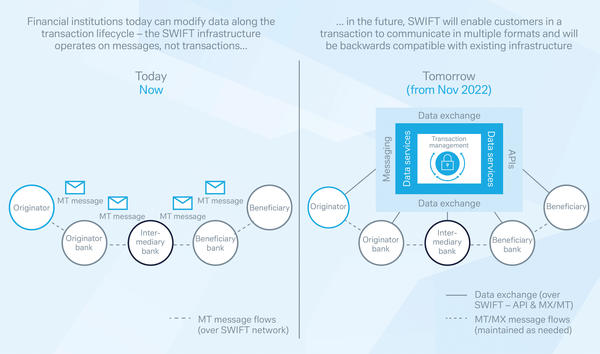
Correspondent banking continues to develop at speed, propelled by huge infrastructure projects and the introduction of new and innovative initiatives. Deutsche Bank’s Marc Recker reviews this evolution and explores the next generation of correspondent banking.
Correspondent banking remains under pressure, as shifting regulatory frameworks, changing customer demands and new competition put the model under the spotlight. There is a sense that the industry is reaching a defining moment that will decide whether it will thrive and continue to be the cornerstone of global trade. But what should banks, and the wider industry, do to ensure correspondent banking does not only succeed, but continues to adapt and evolve to the new real-time world?
Further reading
Going forward, clarity and uniformity of standards will be increasingly central. Fortunately, efforts are well under way in this respect, and have been for some time. More than four years since its launch, Swift’s global payments initiative (gpi) – the global payments standard for correspondent banking – continues to play a major role, while other developments, such as the migration to the ISO 20022 global payment messaging standard and the introduction of Swift’s Transaction Manager, are set to further expedite the evolution.
A new standard for a new era
Standards lie at the heart of correspondent banking. They enable network participants to seamlessly exchange data with each other to execute payments securely and efficiently. In today’s rapidly digitalising world, however, the industry’s existing standards – developed at a time when storage and bandwidth were expensive, and before anti-money laundering and anti-terrorist financing checks became standard requirements – have begun to show their age.
The ISO migration lays the foundation for the future, enabling banks and other participants in the end-to-end value chain to operate much more efficiently
For example, Swift MT formats, the incumbent standard for cross-border payments messaging, have been in use for around four decades but lack the rich, structured information required in today’s data-driven world; an update was due. In response, the payments industry – including domestic, high-value and cross-border payment systems – has begun the transition to the ISO 20022 messaging standard.
The ISO migration lays the foundation for the future, enabling banks and other participants in the end-to-end value chain to operate much more efficiently. It will deliver the information needed for reconciliation and liquidity management in a more structured and automated way, enabling fast, smooth and efficient payment processing. This will, in turn, unlock automated data analytics for improved risk mitigation, increase straight-through processing and enable the development of value-added services for corporate clients.
The journey ahead
Many domestic payments systems, such as Europe’s Single Euro Payments Area (SEPA) and the SEPA Instant Credit Transfer, known as SCT Inst, have already migrated to ISO, while high-value payment infrastructures, such as the Eurosystem, the Bank of England and the Federal Reserve, plan to implement the standard in the coming years. In the correspondent banking space, Swift is set to migrate to ISO in November 2022, after which there will be a coexistence phase where ISO and MT legacy messages will exist in parallel until November 2025.
This impending deadline leaves banks with plenty of preparation work. The magnitude of the task ahead is substantial, and the effort required from banks remains significant. It will mean pushing forward internal projects – ensuring schedules are prepared, resources secured, budgets allocated and senior management informed ahead of the shift. Internal preparation should also be matched by external preparation. Education will be a key factor in this respect. ISO is not only a technological challenge: it will touch every aspect of the end-to-end payment chain and systems. Colleagues and clients alike should understand and be ready to consume the new standard from day one.
Next-generation transaction management
As part of a strategy to minimise friction, optimise speed and provide end-to-end transparency and predictability for cross-border payments, and facilitate a seamless migration to the ISO standard, Swift is introducing a new platform, known as the Transaction Manager, which will centrally maintain the full ISO 20022 transaction data.
Under the current model, financial institutions must pass all messaging data down the chain but, during the transaction life cycle, this data can be modified. It means that the least rich, or ‘weakest’, message format in the chain determines what data is received by the end beneficiary. Swift’s new platform will hold a central copy of the complete payment data, which will be accessible to every bank in the payment chain. This will allow rich data to be exchanged from end to end, thereby removing issues surrounding the weakest link in the chain, unlocking new services, streamlining processes and providing various compliance benefits.
In addition, the platform will mediate between banks using the MT (FIN-based), ISO 20022 or application programming interface (API) channels – allowing banks to adopt ISO 20022 at their own pace during the coexistence period. This means that participants also need not wait until all parties in the payment chain are ISO-enabled but can reap the benefits of the new standard once they themselves have migrated.
More than just about increasing efficiency
While the migration to ISO 20022 and the introduction of Transaction Manager will undoubtedly lead to major efficiency gains in the cross-border payments space, for correspondent banking to truly thrive the industry will have to continue to innovate, take advantage of trends in the market and respond to changing customer demands.
By working together as a community, the industry can achieve more from the correspondent banking network than when it operates alone
A good example is capitalising on the growth of cross-border payments in the consumer-to-consumer, consumer-to-business and business-to-consumer segments, which are typically low-value. Here, banks have been fairly slow to respond to competition in the market, despite the advantage of having the network at their disposal. In these specific segments, clients are typically demanding full principal pay solutions with end-to-end pricing transparency upfront, and a processing experience that is equal to the one they have with domestic payments.
If banks work collaboratively, they should be able to deliver this experience. The first steps have already been taken and much of the groundwork has already been laid with Swift gpi. Currently, about 20 banks, together with Swift, are developing an initiative to improve the experience for small and medium-sized enterprises and consumers that want to send low-value payments across borders. It will incorporate transactions with full principal amount, upfront fee predictability, no deductions and, for markets with instant or real-time capabilities, adoption of gpi Instant will enable instant settlement.
This initiative is a real chance for banks to regain and capture further market share. More information on it will be announced in the coming months, but it is an excellent example of how banks can work collaboratively to deliver on client requirements.
Such collaboration need not be limited to Swift. By working together as a community, the industry can achieve more from the correspondent banking network than when it operates alone. There is currently a lot of duplication in the sector, which gives banks an opportunity for attain significant cost savings and more resilient infrastructures. Take compliance processes for example: rather than each bank building, maintaining and improving its own infrastructure, they could connect to a central service provider via an API. Central utility services such as this – for processes that are less value-add and more must-have – could bring significant benefits in the future.
The road ahead
The correspondent banking industry continues to evolve in its journey towards an instant and frictionless future in which cross-border transactions can be performed between accounts anywhere in the world. There is, however, still some distance to travel and the large transaction banks, such as Deutsche Bank, are expected to lead in delivering initiatives without compromising the network.
The implementation and development of harmonised global cross-border payment standards, such as ISO 20022 and Swift gpi, as well as continued industry collaboration to improve the global correspondent banking network, will be major next steps if the vision is to become reality. But with the right initiatives, coupled with strong co-operation with Swift and the wider industry, banks can become a one-stop shop for fast, efficient payments of all kinds.
Marc Recker is managing director, global head of product, institutional cash management at Deutsche Bank.



